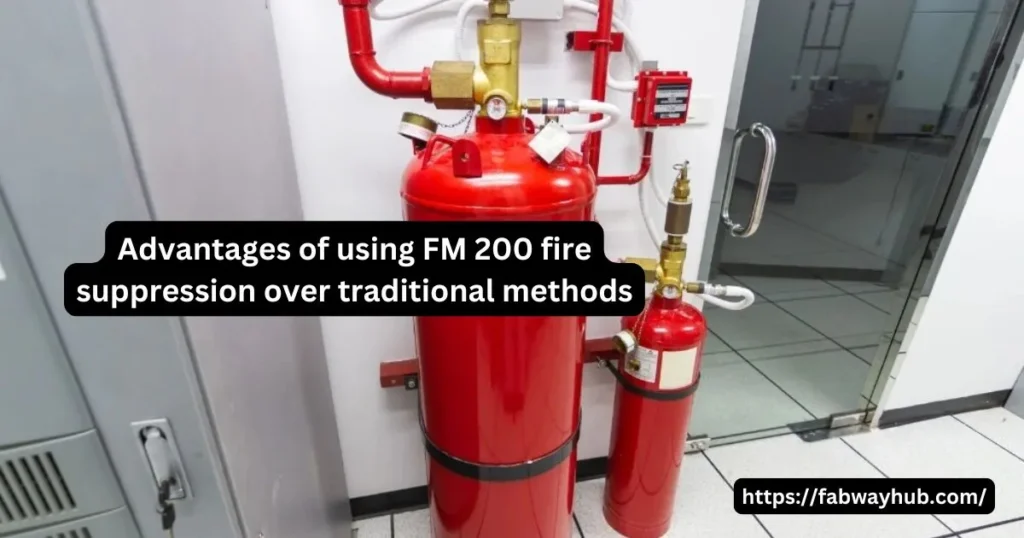The demand for fire suppression systems is key to protecting the lives and property of people as well as preventing significant economic losses due to the damage caused by fires. With the evolution of technology, modern solutions such as FM 200 fire suppression systems have been gaining popularity due to their versatility. Typical techniques such as water sprinklers, chemical powders, or foams have their limitations, which FM 200 overcomes very well.
FM 200 Fire Suppression What is FM 200 Fire Suppression?
FM 200 fire, or HFC-227ea, is a gaseous fire suppression agent that extinguishes fires by interfering with the chemical reaction that takes place during combustion. The chemical is stored as a liquid and deployed as a gas, making it ideal for protecting sensitive equipment and enclosed spaces.
Chemical Structure and Mode of Action
FM 200 agent is a halocarbon, which means it acts primarily by absorbing heat and inhibiting chemical combustion through a process. This also does not leave any residue like water or foam systems, making it a clean and effective fire extinguishing agent.
Modern Industry Applications
FM 200 is extensively used in data centers, healthcare facilities, and libraries as it suppresses fire without leaving residue or damaging the electronics and other sensitive assets.
How traditional fire suppression systems work
Most of these traditional systems use water, foam, or chemical powders. Although they are highly effective under specific circumstances, they can inflict considerable damage on property and necessitate extensive cleanup.
Water-Based Systems
Fire Suppression Tools: Sprinkler Systems. But they can lead to water damage and are therefore unsuitable for spaces where electronics or archives are housed.
Chemical Powders and Foams
Powder-based systems batten down blazes but leave behind a residue that can harm machinery and involve expensive post-deployment cleaning.
FM 200 vs. Traditional Systems.
Rapid Response and Efficiency
FM 200 is deployed in seconds, containing the fire before it can spread. This rapid response reduces the fire spread and limits the damage to a fraction of what occurs with slower water systems.
Less Downtime During Deployment
While systems that work like a sponge require a lot of cleaning up, FM 200 fire doesn’t leave any residue, so you can get back to business sooner after an incident.
No Water Damage to Assets
One of FM 200’s biggest benefits is its gas-based application — no risk of water damage. As a result, it is the best option for preserving electronics, archives, and sensitive machinery.
FM 200 and its Environmental and Safety Features
Ozone-Friendly Properties
FM 200 has an ozone depletion potential (ODP) of zero and is therefore considered safe for the environment. It also conforms with the global zeolite environmental regulations, and is a force for fire prevention.
Safe for Occupied Spaces
At regular application concentrations the agent is non-toxic, so it is safe for any floors for which it is applied as well as the persons present during deployment. This is an important advantage compared to CO2 systems, which can be a danger in occupied spaces.

Installation and Maintenance
Ease of Installation
FM 200 fire systems occupy less space when compared to storage which is required by water or foam. Their modular design makes installation easy in lots of different scenarios.
Reduced Maintenance Needs
These systems tend to need little maintenance as they age, so they avoid the costs of maintenance work and offer peace of mind when they are needed.
Cost-effectiveness of FM 200
Reduced Damage Repair Costs
Since FM 200 can do no harm to assets or structures, it significantly reduces post-fire repair and replacement costs for the organization.
Long-term Operational Savings
The system’s efficiency, low maintenance and practical downtime translate to significant savings during its lifecycle.
Myths Surrounding FM 200
Is It Harmful to Humans?
In usual situations, FM 200 fire suppression is not hazardous to humans. But concentrations need to meet defined safety standards for safe and effective protection.
Will It Work for Every Space?
FM 200 is versatile, but not as a good choice in open or very ventilated locations, for the agent may disperse a lot.
The Industries that FMS 200 Benefits the Most
Learn about DC and IT Facilities
FM 200 provides excellent protection for critical IT infrastructure with no risk of water damage, helping with business continuity.
Hospitals and Healthcare
Without having any harmful effects on important medical equipment and the safety of patients, FM 200 offers fire safety.
NOTE: · The above are set-ups for Industrial and Manufacturing purposes.
It is perfect for environments with complex machinery, where traditional techniques may cause irreparable harm.
Conclusion
Nonstop FM 200 fire extinguisher lines up against the common techniques, yielding incomparable benefits such as active addressing of build-up hazards, protecting valuable property, being eco-sensitive, and delivering long-term financial solutions. For modern fire safety requirements, electric fire pumps are the ideal solution owing to their versatility and dependability.
FAQs
Why is FM 200 better than water-based systems?
FM 200 does not leave a residual behind and yields zero water damage, meaning it is perfect for electronics and other delicate assets.
Is FM 200 safe for humans?
FM 200 is harmless when used according to the safety guidelines and can be used in places containing humans.
What is the deployment time of FM 200?
Within seconds, FM 200 is activated, for quicker fire suppression.
Is FM 200 suitable for use in big spaces?
Yes, but it works best in closed or semi-closed spaces.
Is FM 200 environmentaly friendly?
Yes, meeting global environmental standards, it has zero ozone depletion potential.